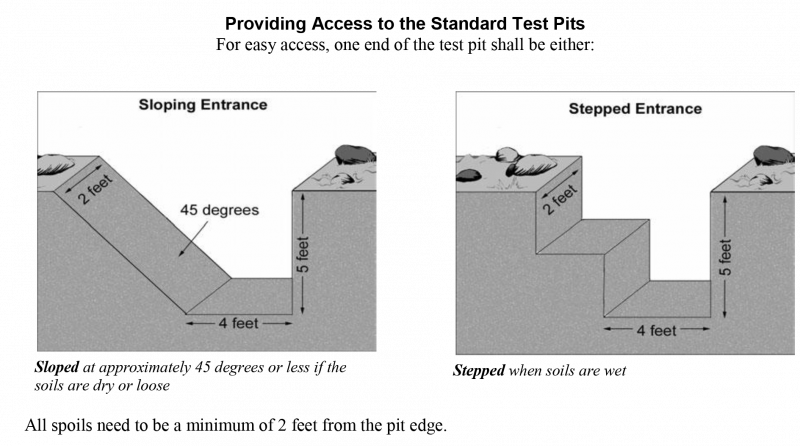Site Evaluation - Research Checklist
What is a Site Evaluation?
A site evaluation is an investigation of a property to determine if it is capable of adequately treating wastewater in order to prevent risk to public health and reduce the degradation of water quality and the environment.
If an Environmental Health Specialist determines the site is suitable for an onsite wastewater treatment system, they will identify the approved location and type of onsite wastewater system allowed for both the initial and replacement dispersal areas. If there is not enough useable area or not enough effective soil for a standard drainfield there are alternative onsite systems that can operate with less area and/or effective soil depth. The onsite evaluation rules require that all system types are considered before denying a property for any onsite wastewater treatment system.
Click here to print the Site Evaluation Preparation Guide
When is a Site Evaluation Required?
A site evaluation is required before any onsite wastewater or building permits can be issued for existing lots, or when partitioning or creating new lots. The first step to approval for a new onsite wastewater treatment system is the site evaluation.
If a valid site evaluation exists in County records, a new evaluation is not required. However, if the site evaluation on record has incomplete information, the property has been altered or partitioned, or new information (neighbor’s well being established within 100’, driving over the approval area, etc.) has been discovered, a re-evaluation may be required. If you wish to place your drainfield in an area different from the “Approved Area” identified on the existing site evaluation, a new site evaluation will be required.
How do I get started?
Prior to applying for a site evaluation through the Deschutes County Community Development Department, an applicant must prepare a minimum of (3) test pits dug into the soil profile (See Test Pit Requirements below on page), and the property corners need to be located and staked or flagged.
Once test pits are prepared, an applicant may request a site evaluation by submitting a Site Evaluation Application form online. A complete application must include an accurate sketch of the property identifying roads, other landmarks, and the location of the test pits in reference to the closest two property lines.
Large properties may be sketched on a separate sheet of paper but the application form must be signed and submitted along with the sketch.
When necessary, provide a vicinity map identifying the property along with clear written driving directions. Incomplete and/or incorrect information may delay the completion of the site evaluation.
When will the results be available and what do they mean?
After the site evaluation is submitted, Deschutes County attempts to complete all site evaluations within 30 days; however, Oregon Administrative Rule does not require site evaluations to be completed in a specific timeframe.
During the winter, site evaluations may be postponed due to weather and soil conditions. A site evaluation cannot be performed if the ground is frozen or snow covered. If weather or soil conditions impact the timeline of a site evaluation, the applicant or authorized representative will be contacted.
Upon completion of the site visit, a County Environmental Health Specialist will complete a site evaluation report that states the status of the application. If the application is approved, the report also specifies the approved location for the dispersal area, the type and size of onsite system components required, and any special items required for installation of the system. If the site is denied, the report will provide the reasons for denial. The site evaluation letter is mailed as soon as it is ready.
How long is a site evaluation valid?
Deschutes County is confident of all site evaluations less than 15 years old. However, the County must consider the completeness of the existing site evaluation, and if new Department of Environmental Quality (DEQ) rules apply or new information changes the property’s suitability for an onsite wastewater system. Deschutes County will make every effort to permit an onsite wastewater system on a previously approved lot, but will not jeopardize public health in that effort.
Test Pit Requirements
Overview
In order to properly evaluate a site’s ability to treat and disperse wastewater, an Environmental Health Specialist must study the soil profile of the property. This examination is conducted in holes excavated into the ground, known as test pits.
How to prepare test pits
- The applicant should provide a minimum of (3) test pits, although (5) is recommended.
- The test pits should be approximately (60-75) feet apart and located in the area most likely to be used for wastewater dispersal. If the proposed replacement area is located in a different area of the property, at least (2) additional test pits should be dug in that space.
- The test pits should be (4) feet long by (4) feet wide and (5) feet deep to allow a person to get into the pit and see the pit walls clearly. One end of the pit must be sloped or stepped to allow safe access in and out of the pit and to prevent entrapment of children or animals. If it is not possible to dig to a depth of (5) feet, then dig as deep as possible. A licensed Department of Environmental Quality (DEQ) installer is recommended to dig the test pits.


